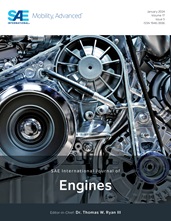Exploring H 2 /O 2 Injection in an Active Pre-Chamber Ignition Engine
- Features
- Content
- Active fuel injection into a pre-chamber (PC) promotes high-temperature and highly turbulent jets, which ignite the cylinder gas with a very high exhaust gas recirculation (EGR) ratio, reducing emissions such as NOx. In the present study, two active PC injection strategies were designed to investigate the effect of injected hydrogen mass and PC mixture air-to-fuel equivalence ratio λ on PC combustion, jet formation, and main chamber (MC) combustion. Stoichiometric or rich hydrogen/oxygen mixtures are actively injected into the PC to enhance the combustion processes in the PC and the MC. A three-dimensional numerical engine model is developed using the commercial CFD code CONVERGE. The engine geometry and parameters adopt a modified GM 4-cylinder 2.0 L GDI gasoline engine. The local developments of gas temperature and velocity are resolved with the adaptive mesh refinement (AMR). The turbulence of the flow is computed with the k-epsilon model of the Reynolds-averaged Navier–Stokes (RANS) equations. The turbulent combustion process is modeled with the extended coherent flamelet model (ECFM). The obtained numerical results, which include MC pressures and heat release rates, align well with experimental data. Detailed analysis is performed to study the effect of the active PC injection with hydrogen on jet properties and turbulence–chemistry interactions. The results reveal that injecting a stoichiometric mixture of hydrogen and oxygen into the PC leads to an EGR limit of 36%, attributed to the high laminar flame speed and adiabatic flame temperature of the mixture, making it an effective method for reducing the engine’s NOx emissions.
- Pages
- 20
- Citation
- Yu, T., Lee, D., Alam, A., Gore, J. et al., "Exploring H 2 /O 2 Injection in an Active Pre-Chamber Ignition Engine," SAE Int. J. Engines 18(2):229-248, 2025, https://doi.org/10.4271/03-18-02-0013.
